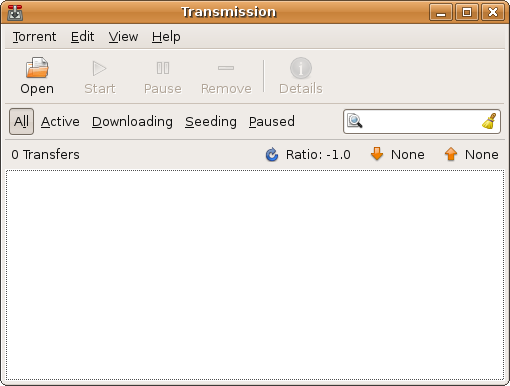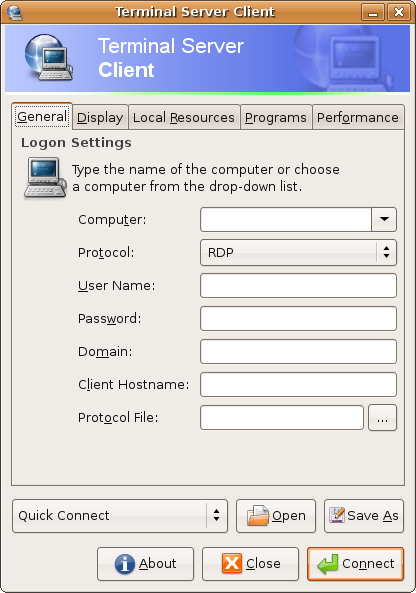Revisiting Linux Part 1: A Look at Ubuntu 8.04
by Ryan Smith on August 26, 2009 12:00 AM EST- Posted in
- Linux
Applications: Everything Else
Sometimes there is an advantage to not being a large, profit-generating target. If you are Microsoft or Apple, there are some things you just can’t take a risk on doing, the consequences of it backfiring are too great. In this case you would never see either of those operating systems include a BitTorrent client. While BitTorrent is legal, it can be used for many illegal things, making it an enemy of groups like the RIAA and MPAA – both of which Apple and Microsoft need to get along with for business reasons (imagine Windows without a DVD player) and because both have deep pockets should a fight erupt.
Canonical (the company backing Ubuntu) is not a large, profit-generating target and as a result they can get away with more here. We’ve already talked about legality issues encompassing codecs, but BitTorrent is another area where their size lets them get away with more. Ubuntu includes Transmission, a full-featured BitTorrent client, making it wholly unique (at least when compared to Windows/Mac OS X) for doing so. As a regular BitTorrent user, this is a most welcome type of application to include.
With there being so many BitTorrent clients I’m not going to get in-depth with features here other than to say that Transmission is a full-featured BitTorrent client. Instead the fact that it’s included at all is a big deal. Although it’s going to be a slight exaggeration, I would put the inclusion of a BitTorrent client up there with a web browser, an email client, or a media player. I consider BitTorrent an essential function, so a proper client is something that ideally would be included with every operating system. It’s that important.

There is one thing I’d like to add about Transmission in particular though. In my time using it, I’m not convinced that other BitTorrent clients are properly respecting it. I’ve noticed that some other clients appear to be ignoring or blocking it, and while it doesn’t appear to be opposed by a large number of clients, it’s enough that in my completely unscientific testing that this looks to make Transmission slightly slower compared to something like Azureus. Wikipedia notes that a version released over 2 years ago was commonly blocked for not being completely compliant with the BitTorrent specification, but I don’t know if this is related or not.
Moving on, there’s one other thing in Ubuntu that caught my eye, and that’s the inclusion of a Remote Desktop Protocol (RDP) client, going under the name of Terminal Services Client. Not to be confused with VNC, the open source remote desktop system commonly used on *nix systems, Remote Desktop Protocol is Microsoft’s proprietary remote desktop protocol and associated applications. While I had expected Ubuntu to include a VNC client, I had not been expecting a RDP client.
As I have a Windows Home Server for file storage and backing up my Windows machines, I need a RDP client to administrate it and the rest of my Windows machines. By “playing nice” and including a RDP client in spite of the fact that the protocol itself is proprietary and Ubuntu does not use RDP itself, this made Ubuntu much more useful for me straight out of the box. Among other things, with it I was able to immediately connect to my server and diagnose why I was having so much trouble connecting to my SMB shares, something which I’ll explain in greater detail in a moment.

Really the only downside to this is that it’s not as well built of a client as Microsoft’s own Windows client is, which is to be expected. Even on a gigabit LAN Terminal Services Client lags a bit compared to the real thing, but then again so does Microsoft’s official RDP client for the Mac. Ubuntu seems to be at a bit of a disadvantage here since it seems that Windows machines have an inherent advantage in being RDP clients. Nevertheless it’s fully usable, it’s just a bit slower.










195 Comments
View All Comments
jigglywiggly - Wednesday, August 26, 2009 - link
I see you shared a lot of the same problems I had with Ubuntu when I first got it. Yeah, it's harder, I won't lie, and it's a pain in the ass when it doesn't work. But when it works, you love it, and you feel like more of a man. I use it for my web server, runs very nicely.Ubuntu sometimes makes you want to shoot it with a m249, but at other times you feel superior to other users. But that's because you are using the terminal all the time and are actually smart, Mac users just need to be shot in the face for their ignorance.
smitty3268 - Wednesday, August 26, 2009 - link
I agreed with a lot of what was in this review.I think a lot of your problems would have gone away by using the newer versions, though, specifically with the package manager. There's much less need for finding things outside of it when you're using the new versions. Even video drivers can usually be put off for 6 months or so if you're not too cutting edge. Leaving the package manager behind is a pain, though, as you found out. You tried to explain that the LTS version was more comparable to Windows/OSX, but in truth very very few desktop users continue to use it. In fact, I'm not aware of any. It's really only used by companies for work machines who don't want to make large changes every 6 months like home users can.
MSTT fonts. Good luck trying to get those by default, they're owned by microsoft who is in no mood to simply give them away to their competitors. Installing them is like installing the patent encumbered video codecs - at your own risk, which is minimal as long as you aren't trying to make money off of it.
It should be mentioned that Red Hat put down some money to buy some nice new fonts a while ago, called Liberation, that are much nicer than the default serif ones this old Ubuntu version was using. Still different than the MS ones, though, which is going to cause some people problems. Also, the font anti-aliasing differences are again due to patents owned by other companies, but there's good news there. They're supposed to expire later this year so better font rendering in Linux should be coming soon! You can already get it working manually, but the distros make it hard to setup.
You mentioned you chose Ubuntu because it was supposed to be user-friendly, which I regard as one of the more puzzling wide-spread myths that go around. Sure, it's a lot simpler than Debian, or some other choices, but it is definitely NOT the distro to choose if you're looking to avoid the CLI, as you found out.
On that note, I would HIGHLY encourage you to eventually go back and do another review (part 3?) that uses a KDE based distro. Maybe try out OpenSUSE next fall, for example. Although KDE is going through a bit of a transition now, it's definitely where all the more interesting stuff is going on. As you said, Gnome is a lot like a boring Windows XP environment, which is both a positive and a negative. KDE is quite different, for better or worse, and is worth a look I think. For one thing, that smb://COMPUTERNAME address will work out of the box in KDE apps. If you do try KDE, I highly recommend another distro besides (K)Ubuntu, though, because they simply don't put any resources into their KDE implementation and it shows.
leexgx - Wednesday, August 26, 2009 - link
Ubuntu KDE has more options to play with that are missing in gnome (but gnome top is far better then KDE top, long time i used linux its task monitor, Linux verson of windows XP task manager but only the process page but very detailed)Ubuntu should be easy to use but it lacks the easy install for drivers and Still does not offer Fail save VGA mode if X windows fails to start your stuck with an command line, it should try an second time but in save mode vga but it does not
Badkarma - Wednesday, August 26, 2009 - link
Thought I'd mention a linux specific site Phoronix has an "Open Letter to Tech Review sites" (http://www.phoronix.com/scan.php?page=article&...">http://www.phoronix.com/scan.php?page=article&....You mentioned linux on Netbooks, and thought I would mention that I found Moblin(www.moblin.org) from Intel very impressive. It's still in beta and a little rough around the edges, but it boots faster than xp resumes from hibernate, around 15sec from bios screen and the UI is designed around small screens. After using it for a few hours and then installing Windows 7, I immediately missed how well Moblin was optimized for the lowres small screen. I had to install W7 because the ath9k kernel module drivers are unstable in Moblin, if not for this I would probably keep it as the primary OS on my netbook.
colonel - Wednesday, August 26, 2009 - link
I ve been using Ubuntu 9.0 for a year with my Dell notebook and i love it, I dont see limitations in my work, the only problem is my company doesn't allow it in the network but is my OS in the houseEeqmcsq - Wednesday, August 26, 2009 - link
I'm still reading it, but on my xubuntu 8.04, my firefox is located in /usr/bin/firefox. Most apps are under /usr/bin.Also, the directory structure is definitely VERY different from Windows. One main difference is that everything that belongs to the user is supposed to be under /home. Everything that belongs to the "system" is everywhere else. I think the theory is that the user stuff is "sandboxed" in /home, so he doesn't mess things up in the system for everyone else.
Penti - Tuesday, September 1, 2009 - link
You have the same in Windows under %SystemDrive%\Documents and Settings\user Although many settings are stored in the register (which can be said to be the equivalent of /etc). It's however there programs like Firefox saves it settings and where you have your My Documents and tempfiles.* %SystemDrive% is a variable and substitute for your systems drive letter on which Windows is installed which can be something other then C:.
fepple - Wednesday, August 26, 2009 - link
On the normal Ubuntu install, the /usr/bin/firefox is actually a symlink that points to the firefox install in /usr/lib :)ioannis - Wednesday, August 26, 2009 - link
the question is, who cares where firefox or any other application's binary is installed? It's not as if you'll go searching for it to run it. They are on your execution 'PATH', which means you can just press ctrl+F2 and type their name, or a terminal, or access them from the application menu.My favourite way is to use something like gnome-go (or krunner in Kubuntu)
PS: yes, all package manager provided application have their binaries in /usr/bin and most user build ones go in /usr/local/bin by default, which is also in your $PATH.
fepple - Wednesday, August 26, 2009 - link
As a developer that has to deal with custom paths or managing symlinks in default paths, I can say I do care where binaries are located ;)